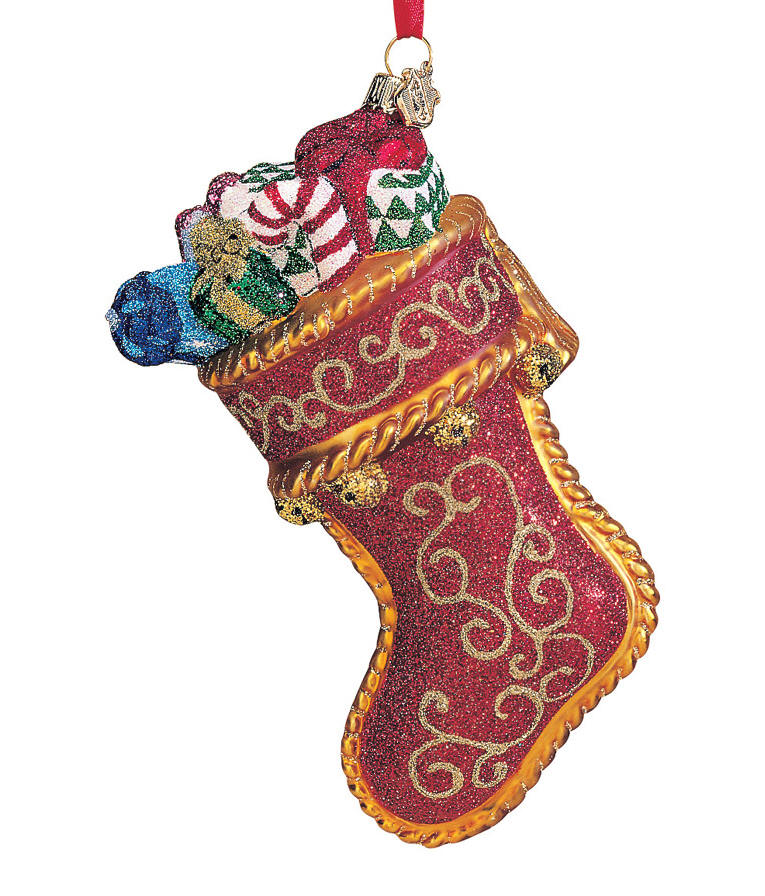Christmas Stocking Stuffers
A Christmas stocking is an empty sock or sock-shaped bag that children hang on Christmas Eve so that Santa Claus can fill it with small toys, candy, fruit, coins, or other small gifts when he arrives. These small items are often referred to as stocking stuffers or stocking fillers. In some Christmas stories, the contents of the Christmas stocking are the only toys the child receives at Christmas from Santa Claus. Other presents are wrapped up in wrapping paper and placed under the Christmas tree. Tradition in western culture dictates that a child who behaves badly during the year will receive only a piece of coal.
By tradition, the stocking is hung on the fireplace mantel, but, since many contemporary homes do not have fireplaces, stockings may be hung in almost any location.
 Christmas Stocking Stuffers
Christmas Stocking Stuffers
The true story of Santa Claus and Christmas Stocking begins with Nicholas, who was born during the third century in the village of Patara. At the time the area was Greek. His wealthy parents died in an epidemic while Nicholas was still young. Obeying Jesus' words to "sell what you own and give the money to the poor," Nicholas used his whole inheritance to assist the needy, the sick, and the suffering. He dedicated his life to serving God and was made Bishop of Myra while still a young man. Bishop Nicholas became known throughout the land for his generosity to the those in need, his love for children, and his concern for sailors and ships.
Through the centuries many stories and legends have been told of Saint Nicholas' life and deeds. These accounts help us understand his extraordinary character and why he is so beloved and revered as protector and helper of those in need.
One story tells of a poor man with three daughters. In those days a young woman's father had to offer prospective husbands something of value—a dowry. Without a dowry, this poor man's daughters were unlikely to marry.A Christmas stocking is an empty sock or sock-shaped bag that children hang on Christmas Eve so that Santa Claus can fill it with small toys, candy, fruit, coins, or other small gifts when he arrives. These small items are often referred to as stocking stuffers or stocking fillers. In some Christmas stories, the contents of the Christmas stocking are the only toys the child receives at Christmas from Santa Claus. Other presents are wrapped up in wrapping paper and placed under the Christmas tree. Tradition in western culture dictates that a child who behaves badly during the year will receive only a piece of coal.
By tradition, the stocking is hung on the fireplace mantel, but, since many contemporary homes do not have fireplaces, stockings may be hung in almost any location.
 Christmas Stocking Stuffers
Christmas Stocking StuffersThe true story of Santa Claus and Christmas Stocking begins with Nicholas, who was born during the third century in the village of Patara. At the time the area was Greek. His wealthy parents died in an epidemic while Nicholas was still young. Obeying Jesus' words to "sell what you own and give the money to the poor," Nicholas used his whole inheritance to assist the needy, the sick, and the suffering. He dedicated his life to serving God and was made Bishop of Myra while still a young man. Bishop Nicholas became known throughout the land for his generosity to the those in need, his love for children, and his concern for sailors and ships.
Through the centuries many stories and legends have been told of Saint Nicholas' life and deeds. These accounts help us understand his extraordinary character and why he is so beloved and revered as protector and helper of those in need.
One night after the daughters had washed out their clothing, they hung their stockings over the fireplace to dry. That night Saint Nicholas, knowing the despair of the father, stopped by the man's house after the family had gone to bed. He peeked in the window and saw the daughters' stockings hanging by the fire.
Inspiration struck Saint Nicholas, and he took three small bags of gold from his pouch and threw them carefully, one by one, into the stockings. The next morning when the daughters awoke, they found their stockings contained enough gold for them to get married. The bags of gold, tossed through an open window, are said to have landed in stockings or shoes left before the fire to dry.
This led to the custom of children hanging stockings or putting out shoes, eagerly awaiting gifts from Saint Nicholas. Sometimes the story is told with gold balls instead of bags of gold. That is why three gold balls, sometimes represented as oranges, are one of the symbols for St. Nicholas. And so St. Nicholas is a gift-giver.
The tradition began in many European countries. Originally, children simply used one of their everyday socks, but eventually special Christmas stockings were created for this purpose. Today, stores carry a tremendous variety of styles and sizes of Christmas stockings, and Christmas stockings are also a popular homemade craft. Many families create their own Christmas stockings with each family member's name applied to the stocking so that Santa will know which stocking belongs to which family member.
The tradition began in many European countries. Originally, children simply used one of their everyday socks, but eventually special Christmas stockings were created for this purpose. Today, stores carry a tremendous variety of styles and sizes of Christmas stockings, and Christmas stockings are also a popular homemade craft. Many families create their own Christmas stockings with each family member's name applied to the stocking so that Santa will know which stocking belongs to which family member.
Christmas Stocking Stuffers Christmas Stocking Stuffers
Christmas Stocking StuffersChristmas Stocking Stuffers
 Christmas Stocking Stuffers
Christmas Stocking Stuffers Christmas Stocking Stuffers
Christmas Stocking Stuffers Christmas Stocking Stuffers
Christmas Stocking Stuffers
Source: images-cdn01.associatedcontent, christmas, blogfabulous, greenlivingonline, malaland, marthastewart, teamsugar